Some people think that conversation has run dry when you start talking about the weather. They’re obviously not gardeners–or even golfers or joggers or construction workers. Weather matters. And I can’t think of many things nearly as fascinating.
Here in the far southwestern corner of the country it’s been dry. Scary dry, almost. I have buckets below the eaves to catch and save runoff from the roof, and even last week’s “big rain” day didn’t fill them more than half way. At least the storm had the decency to drop some rain by the time I was leaving work so that I didn’t feel like a fool for bringing an umbrella and taking the car instead of riding my scooter.
Today we’re in Day Two of a several days of predicted light rain. I’ll keep my fingers crossed.
It’s not that I don’t appreciate the sunny days. Last month we picked a bright weekend–we had many choices–to head east, into the desert. Destination: Salvation Mountain.
I’m about as religious as Howard Stern is subtle, but you couldn’t not to feel the earnestness of this big pile of folk art.
The whole installation is built into a hillside, using not much more than haybales, mud and paint. As we walked over it you could hear things crunching underfoot. Without constant maintenance the whole thing would start to degrade into the desert around it.
This is a polaroid that someone had left showing Leonard Knight, the man who built this. He gave me a detailed personal tour the last time I visited, maybe five years ago. But the news reports last fall mentioned that Mr. Knight’s dementia was taking over, and he had been institutionalized in a facility in El Centro. For an artwork as fragile as this is, it seemed like this winter might be the last time to see the place in the state that he left it, before the desert claimed it.
The side of the Mountain that faces west is crossed by a painted yellow path up the mountain that you can see in this image, the Yellowbrick Road.
I’m not sure what the main highway from the Wizard of Oz has to do with the Christian messages being communicated, but there it is. Please stay on it.
People bring stuff here. This bible, blowing in the wind, fits right in.
Something else people bring here is paint, thousands of gallons of it. Used to be, you came to Salvation Mountain, you’d bring a bucket of paint. It was a great way to share paint leftover from projects. The word now, though, is that people should leave their paint at home, now that Mr. Knight isn’t able to do anything with it.
Built into one size are a series of grottoes that appear to have been built as little shrines. On a scorching midsummer day these spaces are a cool escape. People have brought contributions here too, but I’m not sure if the angel and bowling trophies were original to Leonard Knight’s original vision.
Parked in front are several art cars that have been customized by Mr. Knight. At this point I’m sure they’re fixed sculptures and no longer mobile.
[ Details of the art cars… ]
Another feature of the Mountain is the side maze-feature, made of telephone poles, salvaged trees and more haybales, mud and paint. It’s hard to photograph but would work great as a video shown from inside as you walk through it.
Here’s a view from inside the maze, looking up.
As long as we were way out in the desert, we stopped by the shores of the Salton Sea, just a couple miles away.
Part of the south shore is set aside as the Sonny Bono Salton Sea National Wildlife Refuge. (Yes, that Sonny Bono, Cher’s late ex.) You don’t see any in this picture, but birds were everywhere. You hear about the Pacific Flyway but it’s always a stunning experience to visit one of the main avian truckstops along the route.
And with this image we return to the theme of rain and water. This viewpoint is a fairly famous one. I’ve seen a few photos shot from here, with trees covered in birds and still water below, reflect birds and trees. (I have a few old shots myself.) But that was probably ten years ago.
Southern California has been drawing increasing amounts of water that was formerly used by farmers around the Sea. With less agricultural runoff to feed it, the water level has been dropping, so that the Sea itself is now a quarter mile away.
My little buckets of water, plaintively waiting for the rain, probably will do next to nothing to restore the Salton Sea. But a drop in the bucket is more than nothing at all.


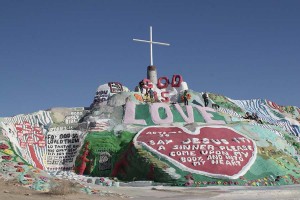
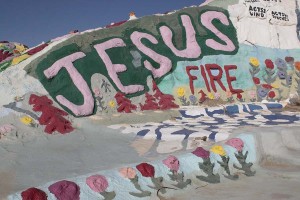
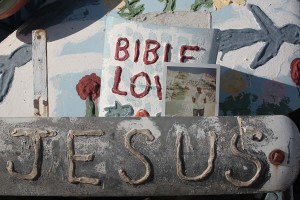
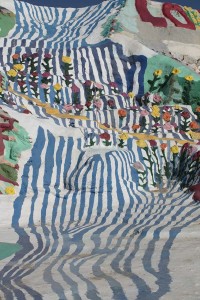

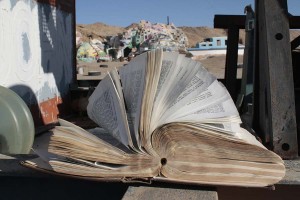
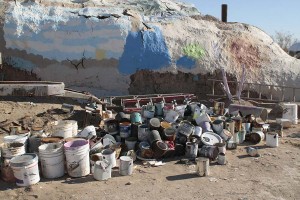
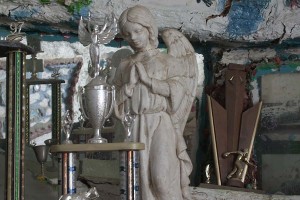
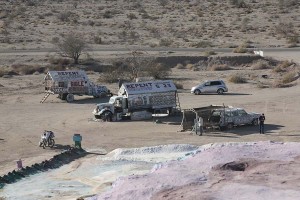
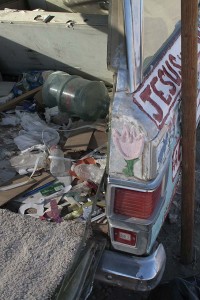
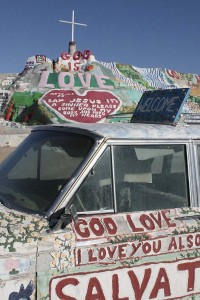
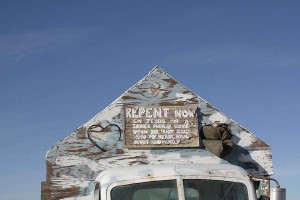

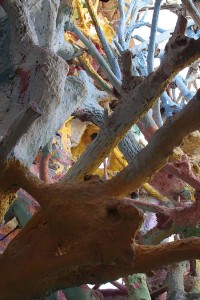
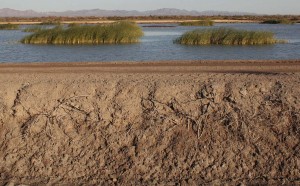

What will happen to the Salton Sea, and the birds?
Yes, very dry. In ten years I’ve not experienced as little rain or snow here in Central CA mountains. We’ve had four imperceptible rains since October 1st when usually it’s 12-15 inches by now. A winter for the history books, but then why not? We tend to expect what we always have, not thinking of any of any time period not our own.
I would imagine that the Salton Sea will do what it has always done, diminish imperceptibly to the eye but not the centuries. Here we’ve had a “50 year snow” and most of California has experienced drought through my lifetime. Will be waiting to see the effect of this ‘winter’ and hope it’s not to bad for any individuals. I sure have been enjoying the sunny weather each day we’ve had it.
Great post! I love your photos and history of Salvation Mountain. That structure is probably the only thing around benefiting from not getting rained on.
Thanks for reminding me that the Salton Sea is a flyway stop off—it always seems so otherworldly.
I’m with you waiting on rain. Dry up here, too, with just light washings off from passing storms.
We’ve had the driest winter on record (since 1865, I believe, and that 8 is not a typo). Very scary. The plants cope somehow, but I’m worried how they’ll do when it warms up.
I’ve wanted to see Salvation Mountain and the Salton Sea for years. There are a few too many good climbing areas between here and there, so I’ve never made it, unfortunately. It looks awesome. That’s too bad about the creator going to a home.
I hear you about the weather. It’s hard to not be obsessing about it.
Salvation Mountain reminds me of the Watts Towers: one man’s vision backed up by the energy and perseverance to see it through. I view it as a form of genius, but for many I would guess that it would be hard to decipher just when “dementia” replaced commitment.
Extraordinary. And a little disturbing. One wonders what led him to start such a project in the first place – it will be interesting to see whether anyone starts to repair it all as the desert makes inroads, or whether it will just gradually be re-absorbed into the landscape. Though I worry what all that paint will do to the ecosystem?
Sad to see a natural wonder like Salton Sea diminished because of mankind’s water demands. I hope you get some serious rain soon.
Great comment on weather – hardly boring, even where it is often benign (like San Diego), let alone where it is wild. Many “professionally”-designed and layperson landscapes fail seems due to ignorance of climate and weather. Oops!
The desert really attracts some people with interesting passions and pursuits. I have always wondered about “Felicity”, just W of Yuma. And so many others. Ed Abbey, Charles Manson, etc…some interesting characters, many that come about being too isolated from others.
EE, the Salton Sea occupies a depression that has cycled through wet and dry over millennia. I think that it last dried up 500-600 years ago, and was basically dry until an engineering accident with water diversion from the Colorado River recreated Lake Cahuilla. If the Sea vanishes into the desert, I suppose the birds will rediscover the Colorado River on their migration routes. But it would be loss for sure.
Sue, some of local water departments are freaking out that people aren’t using enough water to fit their economic projections. If the Sierra snowpack comes in really low this year I expect we’ll be needing to conserve even more–or sip up more of the water that could feed the Salton Sea.
Maggie, the noisy presence of all the birds adds to the surreal sight of a giant brackish lake fed by agricultural runoff that foams at the shoreline from some unknowns that make up the chemical recipe of the Sea. Strange place.
TM, nice to hear your plants are doing okay. Still, I wonder what the long dry summer will do to plants that are likely going to be under drought stress.
Ryan, really, why would a climber want to go somewhere 200+ feet below sea level?! It’s worth the trip, though, in a disaster-tourist kind of way.
Ricki, madness, genius, it all seems part of the same continuum, doesn’t it!? What sane person would do anything like this? But give me a few acres and some paint and a big pile of free time–who knows what we’d come up with?
Janet, the “Why?” questions looms large when you look at something like Salvation Mountain. In lots of ways it’s refreshing to see that kind of focus and energy, enough to turn a Mr. Sourpuss like me into someone a little more hopeful about the quirky, heartfelt things that people decide to do. I know Leonard Knight drew some interest from filmmakers who asked the same question.
David, do I really have to include Charlie Manson in my close circle of assocaites who’ve been transformed by the desert. Ed Abbey–I’m there–but Manson? I guess there’s a guarantee that the desert will change you. How is another matter. Funny about Felicity. I started a post on it when I went through 2-3 January’s ago. I’ll have to dust it off. Talk about strange things going on in the desert. An outdoor museum in the California desert with a big display devoted to French aviation? Only in California. Only in the desert.
So far we are squeaking by for water, since the rain in later January anyway. I have a soft spot for individual projects like this. large or small. I used to live in a suburb of small front gardens many of which were extensively worked over in individual and idiosyncratic ways. Fun to walk the dog there. Santa Cruz has a goodly share of interesting small front yards too. But the scale of this is quite remarkable, from what the photos show.
James, I thought you might be interested in this re: Leonard Knight: http://hwyfly.blogspot.com/2014/02/leonard-knight-of-salvation-mountain.html .
Katie, thanks for the link to the wonderful remembrance. I’d heard about Leonard Knight’s passing but this post was a terrific look back on a fascinating man’s life.